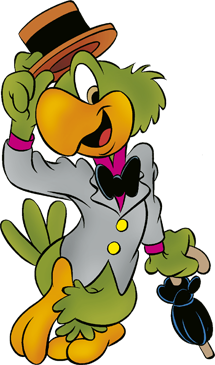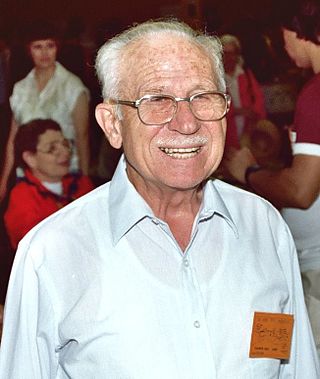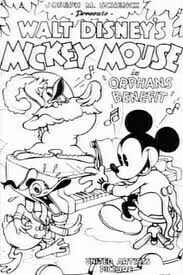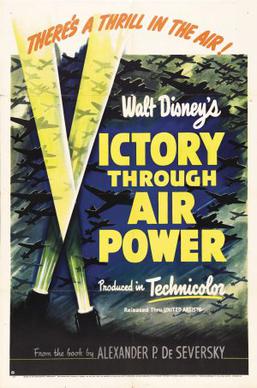
José "Zé" Carioca is a cartoon anthropomorphic parrot created by the Brazilian cartoonist José Carlos de Brito and shown to Walt Disney on his trip to Rio de Janeiro in 1941. The Walt Disney Company then incorporated the idea, being introduced in the 1942 film Saludos Amigos as a friend of Donald Duck, described by Time as "a dapper Brazilian parrot, who is as superior to Donald Duck as the Duck was to Mickey Mouse." He speaks Portuguese. He returned in the 1944 film The Three Caballeros along with Donald and a Mexican rooster named Panchito Pistoles. José is from Rio de Janeiro, Brazil.

Clarence Charles "Ducky" Nash was an American voice actor and impressionist. He is best remembered as the original voice of the Disney cartoon character Donald Duck. He was born in the rural community of Watonga, Oklahoma, and a street in that town is named in his honor. In 1993, he was posthumously made a Disney Legend for his contributions to Walt Disney films.

Donald Gets Drafted is a 1942 American animated short film produced by Walt Disney Productions and released by RKO Radio Pictures. The cartoon has Donald Duck being drafted into the U. S. Army during World War II and follows his introduction to military life. The film was directed by Jack King and introduced the song "The Army's Not the Army Anymore" by Carl Barks and Leigh Harline. The voice cast includes Clarence Nash as Donald, John McLeish as an officer, and Billy Bletcher as Pete who is Donald's drill sergeant.

Orphan's Benefit is an American animated short film produced by Walt Disney Productions in black-and-white. It was first released in 1934 and was later remade in Technicolor in 1941 under the corrected title Orphans' Benefit. It was the 68th Mickey Mouse short film to be released, and the sixth of 1934. The cartoon features Mickey Mouse and his friends putting on a vaudeville-style benefit show for a group of unruly orphans. It contains a number of firsts for Disney, including the first time in which Mickey Mouse and Donald Duck appear together. It was also the cartoon which had the first story to be written that featured Donald Duck, though it was the second Donald Duck short to be produced and released, after The Wise Little Hen.

Der Fuehrer's Face is an American animated anti-Nazi propaganda short film produced by Walt Disney Productions, created in 1942 and released on January 1, 1943 by RKO Radio Pictures. The cartoon, which features Donald Duck in a nightmare setting working at a factory in Nazi Germany, was made in an effort to sell war bonds and is an example of American propaganda during World War II. The film was directed by Jack Kinney and written by Joe Grant and Dick Huemer. Spike Jones released a version of Oliver Wallace's theme for the short before the film was released.

The Spirit of '43 is an American animated World War II propaganda film created by Walt Disney Studios and released in January 1943. The film stars Donald Duck and features writer/designer Carl Barks' prototype for the character Scrooge McDuck. It is a sequel to The New Spirit. The purpose of the film is to encourage patriotic Americans to file and pay their income taxes faithfully in order to help the war effort. The repeated theme in the film is "taxes to defeat the Axis".

The New Spirit is a 1942 American animated short film produced by Walt Disney Productions and the U.S. Department of the Treasury, and released by the War Activities Committee of the Motion Pictures Industry. The cartoon, which stars Donald Duck, was the first film created as part of Walt Disney's World War II propaganda production. It was commissioned by Henry Morgenthau Jr., then Secretary of the Treasury, to encourage American citizens to pay their income tax in support of the war effort. The film was directed by Wilfred Jackson and Ben Sharpsteen, and features Clarence Nash as the voice of Donald, Fred Shields as the radio announcer, and Cliff Edwards singing the theme song.
The third wave of Walt Disney Treasures was released on May 18, 2004. It was originally planned to be released in December 2003, but was delayed for almost half a year in order to meet an increased demand with a higher number of tins produced. This wave was the first to have a certificate of authenticity with the individual number of the tin on it, replacing the number embossed on the tin. This was the final wave released with side straps.
Between 1941 and 1945, during World War II, Walt Disney and his company were involved in the production of anti-Nazi propaganda films for the U.S. government. The widespread familiarity of Disney's productions benefited the U.S. government in producing pro-American war propaganda in an effort to increase support for the war.

Victory Through Air Power is an American adult animated documentary propaganda film produced by Walt Disney Productions and released by United Artists on July 17, 1943. It is based on the 1942 book Victory Through Air Power by Alexander P. de Seversky. De Seversky appeared in the film, an unusual departure from the Disney animated feature films of the time.
World War II changed the possibilities for animation. Prior to the war, animation was mostly seen as a form of family entertainment. The attack on Pearl Harbor was a turning point in its utility. On December 8, 1941, the United States Army began working with Walt Disney at his studio, stationing Military personnel there for the duration of the war. The Army and Disney set about making various types of films for several different audiences. Most films meant for the public included some type of propaganda, while films for the troops included training and education about a given topic.
It's Your War Too is a 1944 short documentary film about the American Women's Army Corps and commissioned by the United States Government during World War II. It contains 1 minute of animation by the Walt Disney Studios. This film, and others, were produced to combat some public backlash against women in the military.

Commando Duck is a Walt Disney anti-Japanese propaganda cartoon starring Donald Duck. It was released on June 2, 1944.

Home Defense is a 1943 animated short film produced by Walt Disney Productions and distributed by RKO Radio Pictures. The film shows Donald Duck and his three nephews Huey, Dewey, and Louie serving as civilian aircraft spotters during World War II. The film was directed by Jack King, Clarence Nash voices the characters.

All Together is a three-minute educational short animated film made by the Walt Disney Studios, for the National Film Board of Canada. The film was released theatrically on January 13, 1942 as part of a series of four films directed at the Canadian public to buy war bonds during the Second World War.

Donald's Decision is a four-minute educational short animated film made by the Walt Disney Studios, for the National Film Board of Canada. The film was released theatrically on January 11, 1942 as part of a series of four films directed at the Canadian public to buy war bonds during the Second World War.
Events in 1943 in animation.

Donald Duck is a series of American animated comedy short films produced by Walt Disney Productions. The series started in 1937 with Donald's Ostrich and ended in 1961 with The Litterbug, with an additional short, D.I.Y. Duck, being released in 2024.













